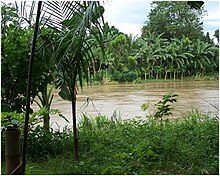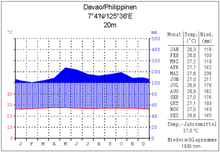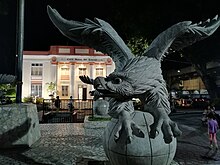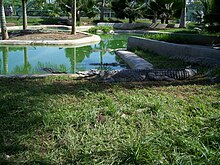Davao City
|
Davao Lungsod ng Dabaw Dakbayan sa Dabaw |
||
| Location of Davao City in the Davao del Sur province | ||
|---|---|---|

|
||
| Basic data | ||
| Region : | Davao region | |
| Province : | Davao del Sur | |
| Barangays : | 182 | |
| District: | 2. District of Davao del Sur | |
| PSGC : | 112402000 | |
| Income class : | 1st income bracket | |
| Households : | 240.057 May 1, 2000 census
|
|
| Population : | 1,632,991 August 1, 2015 census
|
|
| Population density : | 668.3 inhabitants per km² | |
| Area : | 2,443.61 km² | |
| Coordinates : | 7 ° 4 ′ N , 125 ° 36 ′ E | |
| Postal code : | 8000 | |
| Area code : | +63 82 | |
| Mayor : | Sara Duterte-Carpio | |
| Website: | www.davaocity.gov.ph | |
| Geographical location in the Philippines | ||
|
|
||
Davao ( Tagalog : Lungsod ng Dabaw; Cebuano : Dakbayan sa Dabaw ; English : Davao City ) is a city of top category on the Philippine island of Mindanao .
It has 1,632,991 inhabitants (as of August 1, 2015) and with 2,443.61 km² (for comparison: Metro Manila has 638.55 km²) is by far the largest city in the Philippines in terms of area and thus also one of the largest cities in the world. The population density is 668 inhabitants per km².
Sara Duterte-Carpio , who previously held this office from 2010 to 2013 , has been the city's mayor since June 20, 2016 . She thus succeeded her father Rodrigo Duterte , who had previously been mayor of Davao City for several terms from 1988 to 1998, from 2001 to 2010 and again from 2013 to 2016 and who rose to be President of the Philippines in the 2016 election .
Davao City is the largest city in Mindanao and the capital of the Philippines' third largest metropolitan area after Manila and Cebu . It is the capital of the Davao Region (or Region XI) and one of those Filipino cities that are not subordinate to any province, whereby it is included in Davao del Sur for statistical purposes .
Origin of name
Local historians believe that the name Davao is a phonetic mixture of three words from a subgroup of the Bagobo ethnic group language that refer to the Davao River . The local obos who inhabited the hinterland called the river Davoh, the Clatta or Guiangans called it Duhwow or Davau, and the Tagabawa Bagobos used the word Dabu .
The word davoh from the language of the Obos means a place “below the height”. This is due to the fact that their settlement was at the mouth of the Davao River and was surrounded by high hills. When asked where they were going on their way home, they replied: away .
Duhwow, in turn, was a trading center where traders exchanged their natural goods for salt and other necessities.
Other sources report that the name comes from the word "Daba-daba", which means "fire". According to this, Jesuit priests would have named this place so because they noticed a striking number of flames and fires in this area.
geography
Davao City is located in the southeast of Mindanao Island on the Gulf of Davao , into which the Davao River also flows. The urban area is surrounded by the province of Davao del Sur in the south, Cotabato in the west, Bukidnon in the north and Davao del Norte in the east. In the southeast is the coastal area of the city.
The city borders the foot of the island nation's highest peak, Mount Apo . If you turn east from the summit, you come across large plains, untouched forest areas, navigable rivers, and finally arrive at the glittering metropolis.
50 percent of the urban area alone is classified as forested, while 43 percent of the agricultural use is available. The western edge of the urban area already belongs to the Mount Apo Natural Park .
City structure
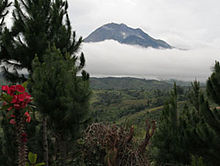
Davao City is divided into eleven administrative districts, which in turn are divided into 182 barangays (districts), the smallest administrative unit in the Philippines.
|
|
|
|
|
climate
Davao City has a tropical climate that is characterized by rainfall, consistently high temperatures and high humidity. There is no pronounced dry or rainy season. The temperatures fluctuate between 20 and 32 ° C with an average rainfall of 2,000 mm per year.
The city lies outside the typhoon belt and is therefore largely spared from strong tropical storms and typhoons .
history
Spanish influence did not take hold in the Davao area until 1848 when an expedition led by Don Jose Oyanguren established a Christian settlement in the mangrove swamps that is now the Bolton Riverbank.
The Davao area was ruled at that time by the Moro chief Datu Bago , whose people lived along the banks of the Davao River. Datu Bago saw the invasion of the Spaniards as a provocation of his claims to power. The result was a fight that ended in favor of the Spaniards. The victory over the ruling Datu marked the end of the sphere of influence of the tribal lords of this area.
On February 27, 1849, the conquest of Davao, begun in 1846, was completed and Gov. Gene. Claveria decreed the division of the Caraga province. The northern part became the province of Surigao, the southern part he named "Nueva Guipozcoa" in honor of his Spanish city of birth and made Caraga its capital. Nueva Guipozcoa was later renamed Davao. Uyanguren made himself the first governor of the area. However, he never achieved his goals for the development of the area.
The American occupation began with the arrival of Major Hunter Ligget in 1890. A few years later, around 1900, the US forces landed, clearing the way for privately owned farms, and assisting in the creation of transportation and communication routes.
Even before the outbreak of the Second World War , Davao was populated by many Japanese immigrants, who played a key role in promoting the area's agricultural development. A Japanese entrepreneur named Kichisaburo Ohta turned large parts of the fertile land into large abacá and coconut plantations . The first wave of Japanese plantation workers reached the place around 1903, and a small district called Little Japan emerged . Here they had their own schools, newspapers, an embassy and a Shinto shrine.
Davao was finally named a notarized city on March 1, 1937 by a resolution of President Manuel Quezon .
In 1941 the Japanese troops occupied Davao and set up a regional headquarters for the occupation army here . The Japanese army brought fear to the Davaoeños, which is why many residents fled to the outskirts of the city. After law and order were restored, most came back and came to terms with the new circumstances. When Davao was liberated by American troops in 1945, the urban area was fiercely contested. Large parts of the city and the surrounding area were destroyed.
In 1945, after the end of the Second World War, there was a strong wave of immigration from the Visayas , from Luzon and other parts of Mindanao to eastern Davao.
On May 8, 1967, Republic Act No. 4867 divided the vast urban area into three provinces, Davao del Norte , Davao del Sur and Davao Oriental . Today's Davao de Oro Province was still part of Davao del Norte at that time. The city remained the area it has today and enjoys a provincial-free status.
population
language
The majority of the Davaoeños have Cebuano as their mother tongue, also known to many as Visayan or Bisayan. Filipino ( Tagalog ) comes in second, just behind the various Visayan dialects. In contrast, the languages that originally developed in the area are now only dominated by minorities. English is used as a teaching language in schools and is therefore widely used, especially among business people and academics.
A mixture of Cebuano (Visayan) and Tagalog with influences from English and Spanish has developed into a social language that is mainly used by the younger generations.
religion
The followers of the Roman Catholic denomination are the dominant religious group in Davao (Dabaw) with 83.83 percent, followed by other Christian groups (15 percent). The remaining 1.17 percent belong to non-Christian denominations such as Muslims and Buddhists .
politics

Davao City Council has a certain degree of autonomy in municipal affairs under the Local Government Code of 1991. The city is divided into three congress districts. The first congress district includes the subordinate districts of Poblacion (city center) and Talomo, the second congress district Agdao, Buhangin, Bunawan and Paquibato, and the third congress district Baguio, Calinan, Marilog, Toril and Tugbok.
The city's mayor is elected every three years but can remain in office for a maximum of three consecutive terms. A later re-election after an official suspension is possible.
Mayor of Davao City:
- Santiago Artiaga (1937-1938)
- Agustin Alvarez (1938–1940)
- Pantaleon Pelayo, Sr. (1940-1941)
- Alfonso Oboza Sr. (1941-1942)
- Juan Sarenas (1943-1944)
- Donato Endriga (1944-1945)
- Apolinario Cabigon (1946)
- Fundador Villafuerte (1946–1947)
- Leon Garcia (1947-1949)
- Bernardo Teves (1949-1953)
- Rodolfo Sarenas (1953-1954)
- Julian Rodriguez Sr. (1954–1955)
- Carmelo Porras (1956–1959, 1960–1963, 1964–1967)
- Elias Lopez (1968–1971, 1981–1986)
- Luis Santos (1972-1975, 1976-1981)
- Zafiro Respicio (1986-1986, 1986-1987)
- Jacinto Rubillar (1987–1988)
- Rodrigo Duterte (1988–1998, 2001–2010, 2013–2016)
- Dominador B. Zuño Jr. (1990–1991 during a three-month leave of absence from Rodrigo Dutertes)
- Benjamin de Guzman (1998-2001)
- Sara Duterte-Carpio (2010-2013, 2016 to date)
Town twinning
Davao City has partnerships with the following cities:
Culture and sights
The use of fireworks and similar pyrotechnics as well as smoking are prohibited in large parts of the city. Violation can result in fines, community service, jail time, or a combination of all three.
The city offers sights such as the Eden Nature Park with the adjacent Mt. Apo National Park, the Malagos Garden Resort and Philippine Eagle Center, the Davao Crocodile Park, the GAP Farming Orchard Resort or the island city in front of the city in the Gulf of Davao Samal with numerous beach resorts.
- The Battle Memorial - a historical monument commemorating the longest battle between American and Japanese troops in Mintal in the Tugbok district
- The Camp Domingo Leonor - quarters of the Spanish and later the American army until 1920 (San Pedro St.)
- The town hall, the former town hall until 1926 (San Pedro St.)
- The Davao Museum in Insular Village I, Lanang
- Davao Museum of Social History
- The Eden Natural Park
- The Fort of Datu Bago - Part of the bastion of the Muslim hero Datu Bago who ruled over the land on the Tagloc River, the ancient name of the Davao River
- The Furukawa plantation in Toril
- The Japanese Museum in Calinan
- The Japanese Peace Monument in Mintal
- The Japanese Tunnel - A free access restaurant through a tunnel dating from the Japanese Revolution
- The Lon Wa, a Buddhist temple - the largest Buddhist temple in Mindanao on Barangay R. Cabaguio Ave
- The Malagos Garden Resort in the heart of the city
- The Mindanao Taoist Temple on JP Cabaguio Ave.
- The Monument for Peace and Unity in San Pedro St.
- The old Japanese houses in Mintal, in the Tugbok and Toril districts
- The Osmeña Park in San Pedro St.
- The Ottha Kyosaburu Memorial Shrine at the Mintal Primary School
- The pier of Uyanguren, later governor of Davao (Rodriguez Park, Quezon Blvd.)
- The San Pedro Cathedral - One of the oldest churches in Mindanao. The original structure was built in 1847 in honor of St. Petro , the town's patron. The oldest altar can be admired in the right wing of the cathedral.
- Talomo Beach in the Talomo District
- The Philippine Eagle Center, home to the Philippine national bird , the Philippine eagle (formerly known as the monkey-eating eagle). He is known as one of the largest eagles (wingspan) in the world.
- The Paradise Island Park and Beach Resort (Samal Island)
- Pearl Farm Beach Resort on Samal Island
- Deca Wakeboarding in Mintal (artificial wakeboard facility)
- Crocodile Park in Davao City
- Batcaves Samal Island (one of the world's largest colonies of bats)
- Hagimit Falls Samal Island (several small waterfalls)
- Talikud Island (Coral Garden - Several species of coral)
- The People's Park in the heart of the city ( Poblacion ), which opened in December 2007 on the site of a former sports facility
Economy and Infrastructure
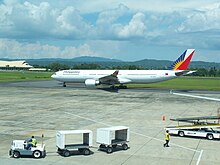
Agriculture is the city's biggest economic factor. Large areas of the urban area are taken up by plantations on which mainly bananas , pineapples , coffee and coconuts are grown. Davao City is also called the Home of Durian , i.e. the home of the Durian (fruit).
The city has an international airport with international connections to Singapore and Kuala Lumpur as well as daily domestic connections, including to Cebu and Manila . In addition, the city has a container port of regional importance with Sasa Wharf . The Ecoland bus terminal also plays an important role for passenger transport, with regular line connections to all of Mindanao and even to distant Manila.
Due to the tense security situation through Islamist (including MILF , Abu Sajaf ) and communist guerrilla groups (including the New People's Army in Mindanao), the tourism industry in Davao is in a difficult position. In the urban area of Davao City, therefore, increased efforts have been made to improve the security situation. The airport in particular, but also other heavily frequented public areas such as shopping malls, have since been subject to strict security controls; there is also a generally high presence of police, military and security personnel in everyday city life. Nevertheless, there have been 6 bomb attacks in the city area since 2000. For example, on March 4, 2003, a bomb exploded in the waiting area in front of the old terminal building of the airport. 21 people died and 145 others were injured in the explosion. The most recent attack to date occurred on September 2, 2016, when a bomb exploded in the busy Roxas night market, killing 15 people and injuring more than 60 others.
On December 23, 2017, after an electrical short circuit, a major fire occurred in the NCCC Mall in the Maa district, in which 38 people were killed. The mall was so badly damaged that it has since been closed and demolition is planned.
media
The oldest newspaper in town is the Mindanao Times , published in 1946 . Other daily newspapers include Sun Star Davao and Mindanao Daily Mirror (since 1950). The Mindanao Post or the Metropolitan Gazette appear weekly . The Philippine Daily Inquirer , based in the capital region , also operates a printing company in Davao.
Colleges
- University of Mindanao
- Ateneo de Davao University
- University of Southeastern Philippines
Foreign bodies
The influence of foreign visitors and the presence of expatriates and immigrants has led the governments of Japan , Malaysia , Indonesia and the United States to each set up their own consulate in the city.
The US Embassy of the Philippines also opened a virtual consulate in the city for processing insurance claims related to VISA cards, foreign affairs and travel information to the United States, which can be requested and processed via the Internet using email and chat can. The website is maintained by Davao University.
sons and daughters of the town
- Alfredo Hua-Sing Ang (* 1930), civil engineer
- Prospero Nograles (1947–2019), politician
- Guillermo Dela Vega Afable (* 1951), Catholic clergyman, Bishop of Digos
- Julius Sullan Tonel (* 1956), Catholic clergyman, Bishop of Ipil
- Abel Apigo (* 1968), Catholic clergyman, Bishop of Mati
- Sara Duterte (* 1976), lawyer and politician
- Lee Van Corteza (born 1979), pool player
- Sheila Mae Pérez (* 1985), water diver
Web links
- Official website of the city administration
- Headlines, comments on Davao ... today
- Davao City website
Individual evidence
- ↑ philstar.com: Duterte siblings sworn in (English), accessed on August 25, 2016.
- ↑ davaocity.gov.ph: Districts , accessed August 10, 2017.
- ↑ https://davaoarchives.wordpress.com/2011/01/24/city-mayors-of-davao-past-to-present/ Mayor of Davao (English), accessed on August 9, 2017.
- ↑ cnn.com at archive.org: Bomb attack on the Philippines ( Memento from December 17, 2004 in the Internet Archive ) (English), accessed on March 25, 2017.
- ↑ philstar.com: Davao attack suspect turns himself in and confesses , accessed March 25, 2017.
- ↑ sunstar.com.ph: Investigation report on the fire in the NCCC Mall completed , accessed on May 19, 2018
- ↑ inquirer.com.ph: Philippine Daily Inquirer , accessed on March 25, 2017.
- ^ Website of the virtual consulate

